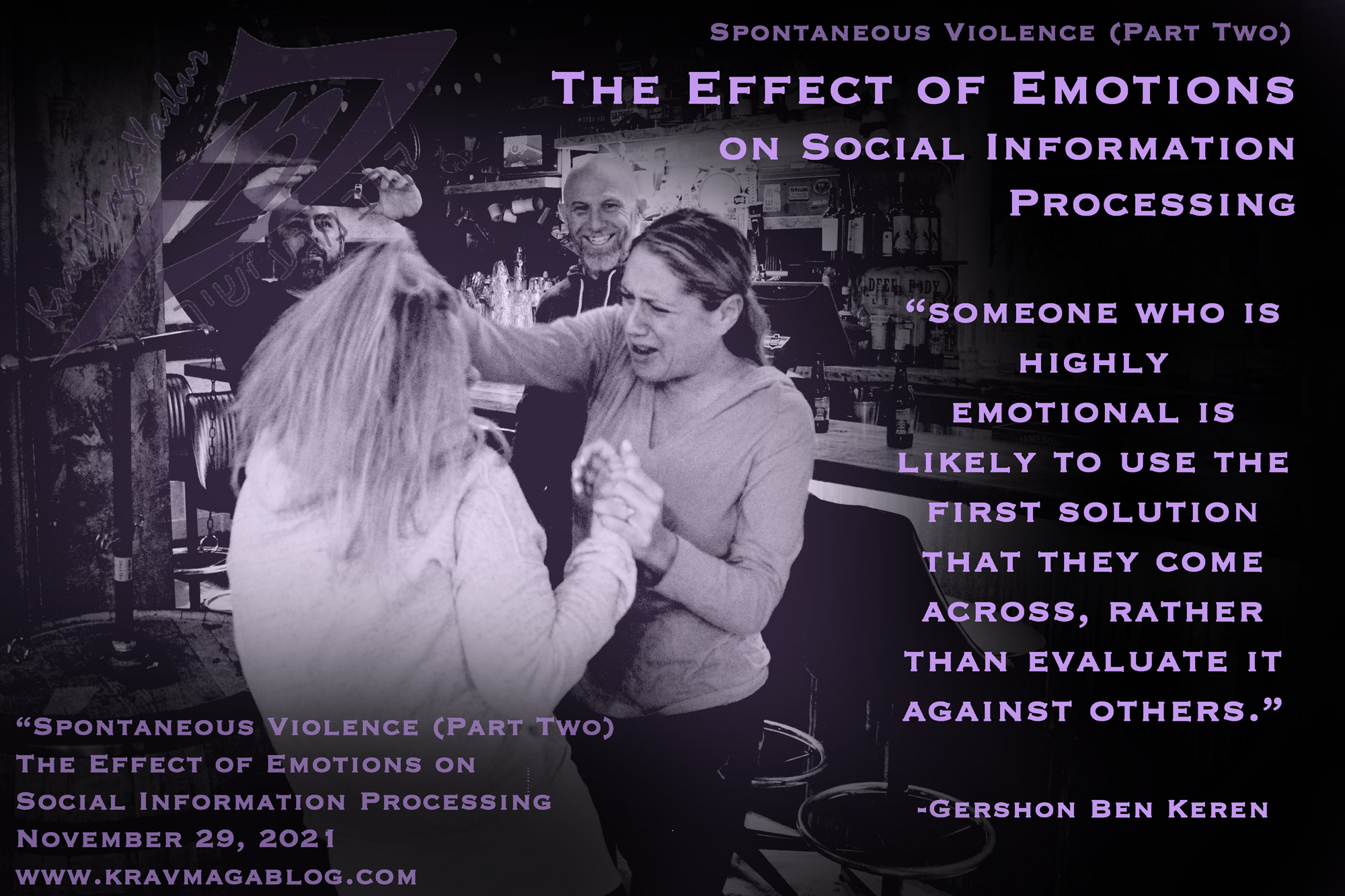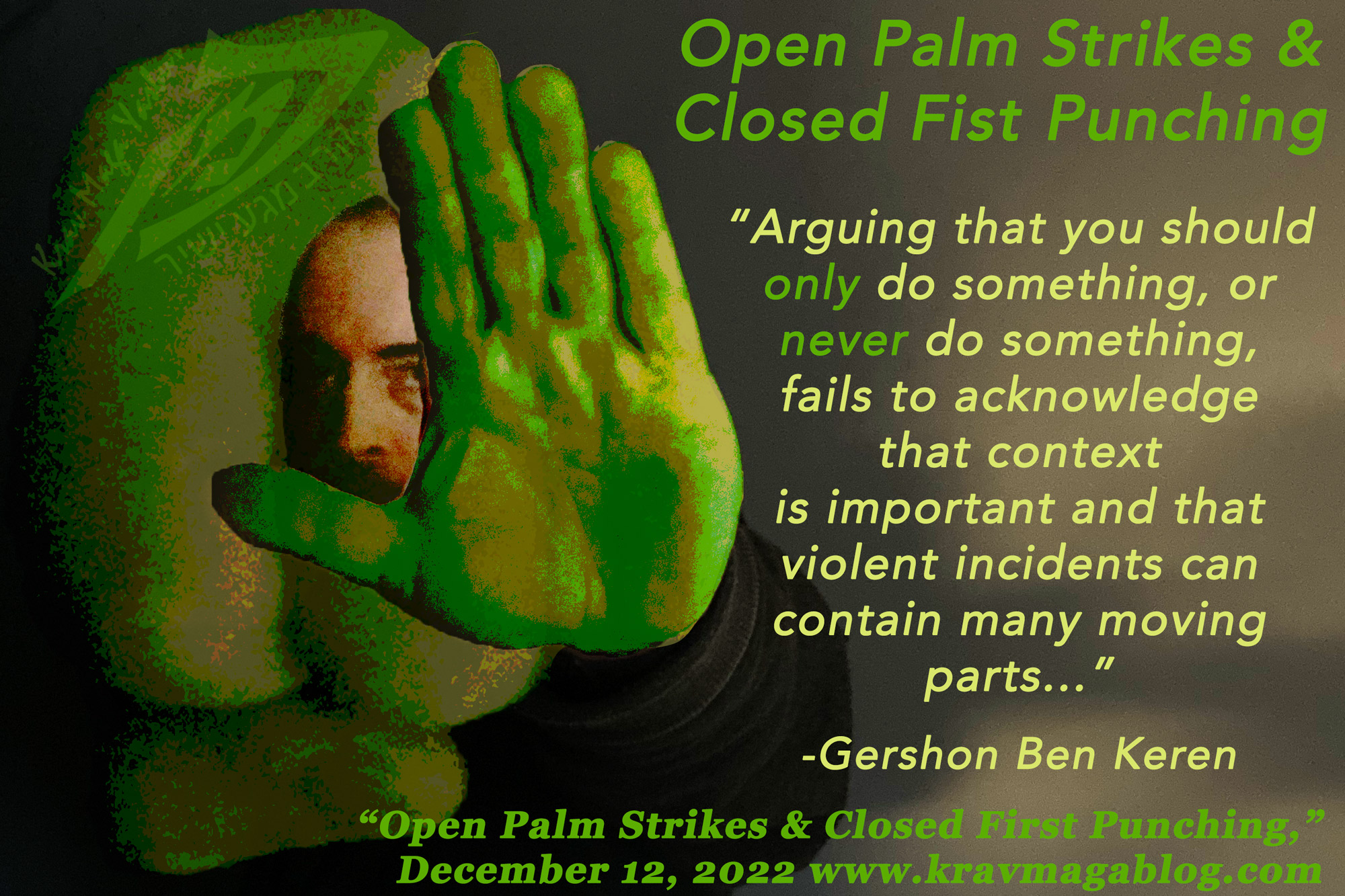Open Palm Strikes & Closed Fist Punching, is an article written by Gershon Ben Keren, a 5th Degree Black Belt in Krav Maga, who teaches Krav Maga in Boston, MA. He has also authored three Amazon best-Selling Books on Krav Maga.
Debates and discussions in Krav Maga and Reality-Based Self-Defense communities are often binary in nature, with one side arguing that “their way” is the only/right way, and the other side is wrong etc. Rarely do opposing groups want all parties to be right, and see acknowledgment of the value of the other side’s point of view, as demonstrating a weakness in theirs. The problem with the adoption of “absolute positions” is that they ignore context. Arguing that you should only do something, or never do something, fails to acknowledge that context is important and that violent incidents can contain many moving parts, requiring those involved to adapt to the situation they are in, rather than blindly follow a set of rules that may work in one context but not in another. In this article I want to re-visit/look at the debate concerning striking with an open hand, and striking with a closed fist. Whilst the discussion is often framed in a “open palm versus closed fist”, I believe that it is the use of “versus” that is divisive and forces people to adopt a camp/side. As I prefer to discuss, rather than argue, and to come out with a better understanding of whatever the subject being examined is, I think the more profitable way to frame the discussion is to look at when and why you might use a closed fist for striking, and when and why you might use an open hand/palm.
From an evolutionary perspective – which I have written about before – there seems more evidence that our fingers “shortened” over time, as we became better, and more dependent on using tools i.e., we needed to get better at making things, and shorter fingers and an opposable (and relatively longer than an ape’s) thumb allowed us to do this. This construction isn’t so great for swinging from tree to tree, but it does allows us to grasp and manipulate things in a much finer and more precise way. Some have argued that our hands evolved in order to make fists, so that we can punch, however there is little evidence for this, because nobody makes a strong fist, that is designed for punching with power, naturally. This is why inexperienced fighters sometimes come away with a “Boxer’s Fracture” or “Brawler’s Fracture”; a fracture of the fifth metacarpal – this is the bone of the little finger, that comes out from the knuckle. This results from the fist connecting with the smaller rather than the larger knuckles, and without the fist and the wrist being properly aligned etc. So the first thing we have to acknowledge about using a closed fist for striking/punching – when we want to connect with the knuckles as opposed to the bottom of the fist when we use hammer-strikes – is that we have to learn to do this, it is not an innate skill we have. Even skilled boxers, such as Floyd Mayweather Jr. and Amir Khan often end up with hand issues; Khan spent most of his career fighting with a broken hand that prevented him from punching full power with his right hand – this being the case, if he was ever involved in a real life altercation, he would probably be better using an open hand/palm as he wouldn’t have to hold back or measure his power. However, closed fist punching does allow us to potentially deliver the most power with our straight strikes, as the force can be focused, and for this reason being able to punch with a closed fist properly is an important skill to develop and have.
Another reason why it is good to learn how to make a fist correctly is that when we become angry/emotional we often clench our hands involuntarily, and we may find ourselves doing this even if it is our intention to strike with the hand open, using the palm. Open hand striking does have several advantages over closed fist punching, though it has to be acknowledged that a degree of force is lost due to the increase in the striking area. However, if someone is going to “pull” their punches because they are worried about causing damage to their fist, then they may actually generate more power with open hand/palm strikes because they will be confident in throwing them with full force and power. There may be times when even though an individual’s default preference is to use closed fist punches, it may be better or them to use open hand strikes. If in a situation an individual’s primary means of self-defense is their firearm, they may want to “preserve” their hand, and reduce the risk of injury, by using open palm strikes instead. There may also be times to mix up the use of open hand and closed fists in a confrontation e.g., a bad open hand strike is generally more effective than a bad punch (closed fist), therefore it may be better to start by using open hand strikes and then transition to punching, as you mentally switch into fight mode. It may also be that if palm strikes are doing the job and achieving their objective - which is to create a safe opportunity for disengagement - you may not want to use closed fist punches as they are more likely to cause serious damage. If your punches end up knocking someone’s teeth out, or fracturing an eye socket – things unlikely to occur with an open hand strike – then you may be creating an opportunity for the other party(s) to bring a civil suit against you for their dental costs etc. It is always worth remembering that in a civil case the burden of proof isn’t “beyond reasonable doubt”, but on the “preponderance of the evidence” – this is often explained/demonstrated by having two even stacks of paper, with one sheet being moved from one to the other i.e., that one extra sheet being enough to result in a guilty verdict.
In general the open hand is a more “versatile” tool as it can be used to both strike and to mask/obscure an assailant’s vision. Fingers can be used to gouge and rake the eyes, after impact etc. However, a correctly formed fist, that can deliver concentrated and focused power is much more likely to deliver concussive force. This benefit does come at a potential cost e.g., a fractured hand, which may mean that one of the tools you had planned on using during a physical confrontation is now inoperable. How/when to use both palm strikes and punches (closed fist) is down to the individual working within the context they find themselves and should not be decided by camps/groups who want there to be absolute truths and singular/exclusionary ways of dealing with violence.
0 COMMENTS














